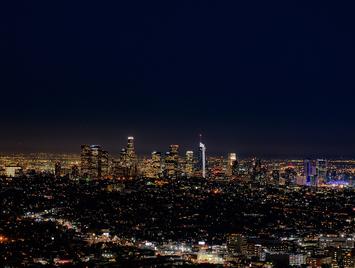
If Los Angeles Mayor Eric Garcetti runs for president, he will no doubt point to the high-rises that have transformed downtown L.A. into something of a hipster haven. He could also point to fevered dense development, both planned and already in process, spreading across the Los Angeles basin, particularly near transit stops, as well as an increasingly notable art scene.
Yet for all the changes in the city, have things improved for most Angelenos? Sadly, the answer is no. For all the speculative capital pouring into the city from China and elsewhere, the L.A. area suffers the highest levels of crowding, the greatest levels of poverty, the least affordable housing, the lowest homeownership rates and the second-largest concentration of homeless in the nation.
In many ways this reflects national trends, where, despite gentrification efforts, the number of poor districts in cities has continued to rise. And there are signs, in the most recent census numbers, that the “back to the city” trend has slowed considerably, including among millennials.
Gentrification is a function of real estate speculation
Compared to other more traditional cities, such as New York or Chicago, multi-polar L.A.’s gentrification reflects less organic development than massive real estate speculation, supported by public dollars and policy. In a new report on gentrification nationwide co-authored with Karla Lopez del Rio and Chapman University researcher Kenneth Murphy, released by the Center for Opportunity Urbanism, barely 1 percent of the city of Los Angeles has gentrified, mostly around downtown.
L.A. gentrification has been driven by changes in zoning, public infrastructure including the rail system, laws promoting density and support for facilities such as the Convention Center as well as Staples Center. The city has lured large developers in some key areas, including Hollywood. The L.A. area ranked as the No. 1 choice in North America in a survey of global commercial real estate investors, who had a combined total of $1.7 trillion to spend on property in 2017.
Yet this investment has not created the kind of job growth we see in Chicago’s Loop, Manhattan or San Francisco. There may be more life and housing in downtown, but downtown’s share of total employment so far has not grown since 2010.
Good for a few, not for many
Neither downtown revitalization nor policies to boost density have made the city richer. New sports stadia have created many lower-wage jobs, but overall L.A. has lost jobs that pay more than $75,000 annually over the past decade. It may have enriched some luxury high-rise developers, but gentrification has not improved life for most. From 2000-12, median rents increased by 25 percent in L.A. County while income declined 9 percent.
It’s dubious there’s anything like a sustainable demand for expensive residences in downtown. Some landlords of luxury apartments offer free parking and periods of free rent. Savvy Chinese real estate website Mingtiandi is warning investors that DTLA is heading for “an imminent glut of luxury condos, amid a wave of up to 30,000 new residential units to hit the city’s market over the next three years.”
Other city-sanctioned high-density developments have had unintended results. Efforts to densify areas around transit stops have boosted prices and rents, but have replaced mostly poor transit riders, who are now compelled to purchase cars, with affluent residents who already drive, notes a recent University of California study.
The politics of gentrification
Perhaps the most controversial impact of gentrification lies with rising rents. This has sparked a grassroots rebellion in the Crenshaw district, Chinatown, south Los Angeles, and, most especially, east Los Angeles. In 2015, a real estate firm littered downtown L.A.’s Arts District with a “Why Rent Downtown When You Could Own in Boyle Heights?” flyer. Realtors promoted a bike tour through the “charming, historic, walkable and bikeable neighborhood.” After the realtor received messages such as “Stay outta my hood” and “I hope your 60-minute bike ride is a total disaster,” the event was canceled.
There is widespread concern about changes in local zoning ordinances, notes Koreatown attorney Grace Yoo, all for developers who built housing out of reach for local residents. Nor is this policy helping to keep L.A.’s beleaguered middle class. Nearly one in five LA census tracts have seen drops in home ownership since 2010, and the city continues to suffer mounting rates of out-migration. Nice restaurants, entertainment and sports venues may be considered cool, and win the plaudits of urban taste-makers, but can’t substitute for affordable housing, higher-wage jobs and better schools, the proven ways of making life better for residents.
If Garcetti wants to make a case for L.A.’s future, not to mention his, he needs to refocus urban policy away from real estate speculation and gentrification to one that serves the need of most middle- and working-class Angelenos. Ultimately the health of a city is not how many restaurants or high-rise towers are built, or how generously developers fill the coffers of accommodating politicians, but how the city serves as an incubator of social mobility.
This piece originally appeared on The Orange County Register.
Joel Kotkin is executive editor of NewGeography.com. He is the Roger Hobbs Distinguished Fellow in Urban Studies at Chapman University and executive director of the Houston-based Center for Opportunity Urbanism. His newest book is The Human City: Urbanism for the rest of us. He is also author of The New Class Conflict, The City: A Global History, and The Next Hundred Million: America in 2050. He lives in Orange County, CA.
Marshall Toplansky is Clinical Assistant Professor of Management Science at Chapman University. He is co-principal investigator, with Joel Kotkin on “The Orange County Model”, a demographic and econometric research project to identify growth strategies for that region. He is formerly Managing Director of KPMG’s national center of excellence in data and analytics, and is co-founder of Wise Window, a pioneer in sentiment analysis and the use of big data for predictive models. He lives in Orange, California.
Photo: Camiloarenivar [CC BY-SA 4.0], from Wikimedia Commons












